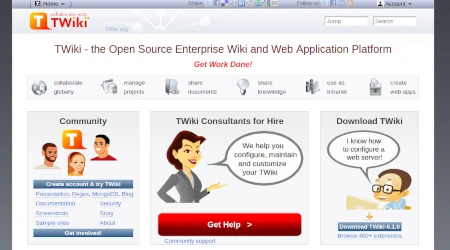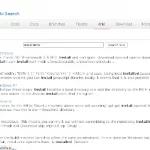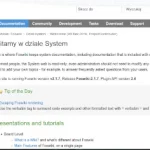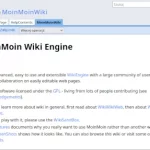Web site: twiki.org
Category: Network
Subcategory: Wiki
Platform: Linux
License: GNU GPL
Interface: Web interface
Wikipedia: TWiki
First release: July 23, 1998
TWiki – a flexible, powerful, and easy to use enterprise wiki, enterprise collaboration platform, and web application platform. It is a Structured Wiki, typically used to run a project development space, a document management system, a knowledge base, or any other groupware tool, on an intranet, extranet or the Internet.
Users without programming skills can create web applications. Developers can extend the functionality of TWiki with Plugins. TWiki fosters information flow within an organization, lets distributed teams work together seamlessly and productively, and eliminates the one-webmaster syndrome of outdated intranet content. TWiki has been downloaded over 700,000 times and is used daily by millions of people in over 100 countries. Some larger deployments have over one million pages and over 10,000 users. TWiki is developed by an active opensource community on twiki.org.
Features:
– Any web browser: Edit existing pages or create new pages by using any web browser. There is no need for ftp or http put to upload pages.
– Edit link: To edit a page, simply click on the Edit link at the bottom of every page.
– Auto links: Web pages are linked automatically. You do not need to learn HTML commands to link pages.
– Text formatting: Simple, powerful and easy to learn text formatting rules. Basically you write text like you would write an e-mail.
– Webs: Pages are grouped into TWiki webs (or collections). This allows you to set up separate collaboration groups.
– Search: Full text search with/without regular expressions. See a sample search result.
– E-mail notification: Get automatically notified when something has changed in a TWiki web. Subscribe in WebNotify.
– Structured content: Use TWiki Forms to classify and categorize unstructured web pages and to create simple workflow systems.
– File attachments: Upload and download any file as an attachment to a page by using your browser. This is similar to file attachments in an e-mail, but it happens on web pages.
– Revision control: All changes to pages and attachments are tracked. Retrieve previous page revisions and differences thereof. Find out who changed what and when.
– Access control: Define groups and impose fine grained read and write access restrictions based on groups and users.
– Variables: Use variables to dynamically compose your pages. This allows you for example to dynamically build a table of contents: include other pages; or show a search result embedded in a page.
– TWiki Plugins: Enhance the TWiki functionality with server side Plugin modules. Developers can create Perl Plugins using the TWiki Plugin API.
– Application Wiki: Contributors use the TWiki platform to create web applications. The TWiki Variables, Plugins and sample applications offer a rich environment where domain-specific applications can be built efficiently by contributors with moderate skill sets.
– Templates and skins: A flexible templating system separates program logic and presentation. Skins overwrite template headers and footers; page content is unaffected.
– Managing pages: Individual pages can be renamed, moved and deleted through the browser.
– Managing users: Web based user registration and change of password.
– Statistics: Create Statistics of TWiki webs. Find out most popular pages and top contributors.
– Preferences: Four levels of preferences: TWikiPreferences for site-level; WebPreferences for each web; user level preferences; and page level preferences.
– Conflict resolution: Content is merged automatically if more than one user is edit a page at the same time. In rare cases where a conflict cannot be resolved automatically, users are warned and guided to resolve the conflict manually.
– Referred-By: Find out back-links to a page.





